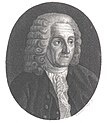
Back Escala Delisle AST Escala Delisle Catalan Delisleskala German Escala Delisle Spanish Delisle gradu Basque مقیاس دلیزل Persian Delisle-asteikko Finnish Delislestigin Faeroese Échelle Delisle French Delisle-Skala FRR
| from Delisle | to Delisle | |
|---|---|---|
| Celsius | x °De ≘ (100 − x × 2/3) °C | x °C ≘ (100 − x) × 3/2 °De |
| Fahrenheit | x °De ≘ (212 − x × 6/5) °F | x °F ≘ (212 − x) × 5/6 °De |
| Kelvin | x °De ≘ (373.15 − x × 2/3) K | x K ≘ (373.15 − x) × 3/2 °De |
| Rankine | x °De ≘ (671.67 − x × 6/5) °R | x °R ≘ (671.67 − x) × 5/6 °De |
| For temperature intervals rather than specific temperatures, 1 °De = 2/3 °C = 1.2 °F Conversion between temperature scales | ||

The Delisle scale is a temperature scale invented in 1732 by the French astronomer Joseph-Nicolas Delisle (1688–1768).[1] Delisle was the author of Mémoires pour servir à l'histoire et aux progrès de l'Astronomie, de la Géographie et de la Physique (Memories to Serve the History and Progress of Astronomy, Geography and Physics) (1738). The Delisle scale is notable as one of the few temperature scales that is inverted from the amount of thermal energy it measures; unlike most other temperature scales, higher measurements in degrees Delisle are colder, while lower measurements are warmer.[a]
- ^ Camuffo, Dario (2002). Improved Understanding of Past Climatic Variability from Early Daily European Instrumental Sources. Kluwer Academic Publishers. p. 314.
Cite error: There are <ref group=lower-alpha> tags or {{efn}} templates on this page, but the references will not show without a {{reflist|group=lower-alpha}} template or {{notelist}} template (see the help page).